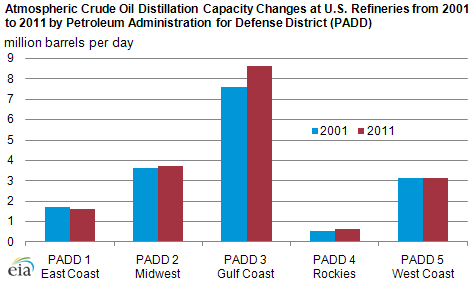
January 2011 U.S. refining capacity was the highest in 29 years

Note: Capacities are as of January 1.
Download CSV Data
Atmospheric crude oil distillation capacity at U.S. refineries was 17.7 million barrels per day at the beginning of 2011 according to the U.S. Energy Information Administration's Refinery Capacity Report. Capacity, which was 0.15 million barrels per day above its level at the start of 2010, reached the highest level recorded since 1982. Since 2001, total net U.S. refinery capacity grew by more than 1 million barrels per day.
Nearly half (49%) of U.S. refinery distillation capacity is located in the Gulf Coast region, which is Petroleum Administration for Defense District (PADD) 3, up from 46% in 2001. Most expansions of refinery distillation capacity have taken place at the larger refineries and most of these large refineries are located in PADD 3. The regional distribution of U.S. refinery distillation capacity outside of PADD 3 at the beginning of 2011 was 9% on the East Coast (PADD 1), 21% in the Midwest (PADD 2), 4% in the Rocky Mountains region (PADD 4), and 18% on the West Coast (PADD 5).
The last major brand new U.S. refinery started operating in 1977 at Garyville, Louisiana. Since then, distillation capacity expansions have come from construction of relatively small refineries and expansion of existing plants. Decreases in refinery distillation capacity resulted mostly from plants that were shut down. In recent years, some refineries have temporarily ceased operation for economic reasons but continue to be counted as operable capacity if they can be returned to service within 30 days.